
A One Day International (ODI) is a form of 50 overs limited overs cricket, played between two teams with international status, in which each team faces a fixed number of overs, currently 50, with the game lasting up to 7 hours. The Cricket World Cup, generally held every four years, is played in this format. One Day International matches are also called Limited Overs Internationals (LOI), although this generic term may also refer to Twenty20 International matches. They are major matches and considered the highest standard of List A, limited-overs competition.
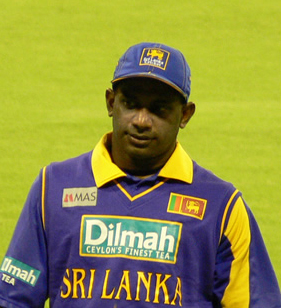
Deshabandu Sanath Teran Jayasuriya, is a former Sri Lankan cricketer and captain, who is widely regarded as one of the greatest ever to play the game. A left arm opening batsman, an orthodox spinner and a dynamic fielder, Jayasuriya together with his opening partner Romesh Kaluwitharana is credited for having revolutionized one-day international cricket with his explosive batting in the mid-1990s, which initiated the hard-hitting modern-day batting strategy of all nations. He was a key member of the Sri Lankan team that won 1996 Cricket World Cup. Under his captaincy Sri Lanka become joint champions along with India in the 2002 Champions Trophy.

The New Zealand national cricket team represents New Zealand in men's international cricket. Nicknamed the Black Caps, they played their first Test in 1930 against England in Christchurch, becoming the fifth country to play Test cricket. From 1930 New Zealand had to wait until 1956, more than 26 years, for its first Test victory, against the West Indies at Eden Park in Auckland. They played their first ODI in the 1972–73 season against Pakistan in Christchurch. New Zealand are the inaugural champions of WTC which they won in 2021 and they have also won ICC CT in 2000. They have played in the CWC final twice and the T20 WC final once.
Short form cricket is a collective term for several modified forms of the sport of cricket, with playing times significantly shorter than more traditional forms of the game.
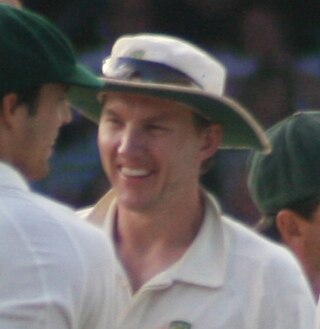
Brett Lee is an Australian former international cricketer, who played all three formats of the game. During his international career, Lee was recognised as one of the fastest bowlers in the world. With his time representing Australia, Lee won multiple ICC titles with the team: the 2003 Cricket World Cup, the 2006 ICC Champions Trophy, and the 2009 ICC Champions Trophy. Lee was the first bowler to take a hat-trick in the T20 format of the game which he did in 2007 ICC World Twenty20 in the inaugural tournament against Bangladesh, subsequently being the first bowler to do so at an ICC Men's T20 World Cup. Lee was also the first Australian bowler to take a hat-trick at a Cricket World Cup which he did in the 2003 Cricket World Cup Super Match game against Kenya.

Shaun Maclean Pollock is a South African cricket commentator and former cricketer, who was captain in all formats of the game. A bowling all-rounder, Pollock along with Allan Donald formed a bowling partnership for many years. From 2000 to 2003 he was the captain of the South African cricket team, and also played for Africa XI, World XI, Dolphins and Warwickshire. He was chosen as the Wisden Cricketer of the Year in 2003. Pollock was a member of the South Africa team that won the 1998 ICC KnockOut Trophy, the only ICC trophy the country has won till date.

Shane Robert Watson is an Australian cricket commentator and former cricketer who played for and occasionally captained the Australian national cricket team between 2002 and 2016. He was an all-rounder who played as a right-handed batsman and a right-arm fast-medium bowler. He was ranked as the world's No. 1 all-rounder in Twenty20 Internationals (T20I) for 150 weeks, including an all-time record of 120 consecutive weeks from 13 October 2011 to 30 January 2014. He began playing during the Australian team's golden era in the early 2000s, and was the last player from this era to retire. In his time playing for Australia, Watson was part of their winning squad in the Cricket World Cup two times in 2007, and 2015 along with the ICC Champions Trophy twice in 2006 and 2009, with Watson named as the player of the match in the final on both occasions, as he scored the winning run in the 2006 tournament, with the winning six in the 2009 tournament.
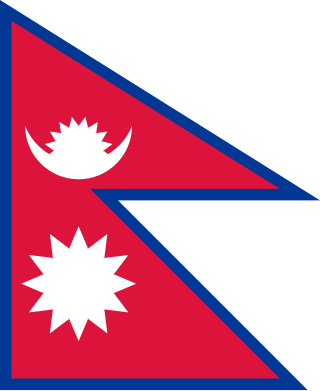
The Nepal men's national cricket team represents the country of Nepal in International cricket and is governed by the Cricket Association of Nepal (CAN). They have been Associate Member of the International Cricket Council (ICC) since 1996. Nepal were awarded Twenty20 International (T20I) status by the ICC in June 2014 until the 2015 ICC World Twenty20 Qualifier and earned One Day International (ODI) status in 2018.

The Scotland national cricket team represents the country of Scotland. They play their home matches at The Grange, Edinburgh, and also some other venues.

Cameron Leon White is an Australian former international cricketer who captained the national side in Twenty20 Internationals. A powerful middle order batsman and right-arm leg-spin bowler, White made his first-class cricket debut as a teenager in the 2000–01 season for the Victoria cricket team as a bowling all-rounder. During his time with Australia, White won the 2009 ICC Champions Trophy.

Brendan Ross Murray Taylor is a Zimbabwean former international cricketer and a former Zimbabwean captain, who played all formats of the game. Taylor is a right-handed batsman but is also an off spinner. In 2015, former Zimbabwe captain Alistair Campbell described Taylor as "our standout player for the last seven or eight years". He is known for his unorthodox shots especially his ability to play upper cuts over the third man and ramp shots with elegance and are often considered as his trademark signature shots. His style of play and ability to make substantial contribution with the bat often drew comparisons with that of Andy Flower. He represented Zimbabwe in four ICC T20 World Cup tournaments in 2007, 2010, 2012 and 2014. Also, he represented Zimbabwe in three ICC ODI world cups as well in 2007, 2011 and 2015.

Daren Julius Garvey Sammy is a Saint Lucian cricketer who played international cricket for the West Indies. He is currently serving as the head coach of the West Indies cricket team in limited overs cricket. On making his One-Day International (ODI) debut against Bangladesh in 2004, Sammy became the first person from the island of St Lucia to play international cricket. Three years later he made his Test debut against England, taking 7/66 which were the best bowling figures for a West Indian in his first Test since Alf Valentine in 1950. Under his captaincy West Indies win the 2012 and 2016 ICC WorldTwenty20. He is the only captain to win the T20 World Cup twice. He was also a member of the West Indies team that won the 2004 ICC Champions Trophy.

Timothy Grant Southee, is a New Zealand international cricketer who plays for New Zealand cricket team in all formats of the game, captain in Tests and vice captain in T20Is. He is a right-arm fast-medium bowler and a hard-hitting lower order batsman. The third New Zealand bowler to take 300 Test wickets, he was one of the country's youngest cricketers, debuting at the age of 19 in February 2008. On his Test debut against England he took 5 wickets and made 77 off 40 balls in the second innings. He plays for Northern Districts in the Plunket Shield, Ford Trophy and Super Smash as well as Northland in the Hawke Cup. He was named as New Zealand's captain for the first T20I against West Indies in place of Kane Williamson, who was rested for that game. The Blackcaps won that match by 47 runs. Southee was a member of the New Zealand team that won the 2019–2021 ICC World Test Championship. Southee currently has the highest (international) test batting strike rate among the batsmen with a minimum of 2000 test runs. His (batting) career strike rate is 83.12.
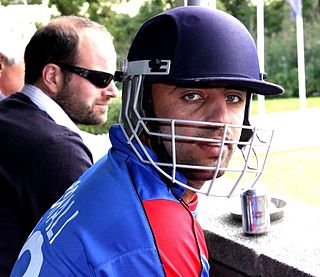
Noor Ali Zadran is an Afghan cricketer who plays for the Afghanistan national cricket team. Ali is a right-handed batsman and a right-arm medium-fast bowler. He cites Ricky Ponting as his cricketing hero and inspiration to play. His nephews Mujeeb Ur Rahman Zadran and Ibrahim Zadran also are Afghan international cricketers.
A Super Over, also called a one-over eliminator or officially a one over per side eliminator, is a tie-breaking method used in limited-overs cricket matches, where both teams play a single, additional over of six balls to determine the winner of the match. A match which goes to a Super Over is officially declared a "tie", and won by the team who score the most runs in the Super Over. If the Super Over also ends in a tie, it is followed by another Super Over.
The following is a list of important cricket related events which occurred in the year 2010.

In cricket, a hat-trick occurs when a bowler takes three wickets. The deliveries may be interrupted by an over bowled by another bowler from the other end of the pitch or the other team's innings, but must be three consecutive deliveries by the individual bowler in the same match. Only wickets attributed to the bowler count towards a hat-trick; run outs do not count, although they can contribute towards a so-called team hat-trick, which is ostensibly a normal hat-trick except that the three successive deliveries can be wickets from any bowler in the team and with any mode of dismissal.

Patrick James Cummins is an Australian international cricketer who captains the Australia men's national cricket team in Test and One Day International cricket. Widely regarded as an all-time great fast bowler in Test cricket and one of the finest fast bowlers of his generation, he captained Australia to victories in the 2021-23 ICC World Test Championship and the 2023 ICC Cricket World Cup. He is also known for being a handy lower-order batsman.
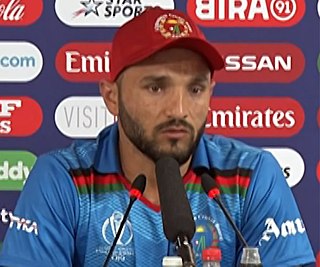
Gulbadin Naib is an Afghan cricketer. An all-rounder, Naib bats right-handed and bowls right-arm fast-medium. In April 2019, the Afghanistan Cricket Board (ACB) named Naib the team's new One Day International (ODI) captain ahead of the 2019 Cricket World Cup, replacing Asghar Afghan. However, following the Cricket World Cup, where Afghanistan lost all of their matches, Rashid Khan was named as the new captain of the Afghanistan cricket team across all three formats. Naib led Afghanistan to the silver medal in the 2022 Asian Games.

















